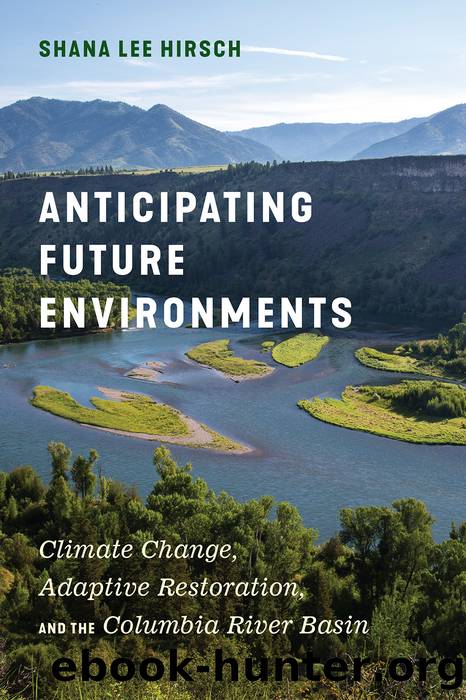Anticipating Future Environments by Shana Lee Hirsch

Author:Shana Lee Hirsch
Language: eng
Format: epub
Publisher: University of Washington Press
Published: 2020-08-15T00:00:00+00:00
EXPERIMENTATION AND EMERGENCE
There are people like Woodruff throughout the Columbia River Basin: people who are experimenting with innovative ways to restore the ecosystem processes that were (sometimes completely) lost as the river and its headwaters were developed and confined by roads, irrigation, and hydropower projects. Some restorationists are even working to engineer ecosystem processes into places they never existed. As described in previous chapters, process-based and engineering-based restoration have been in tension throughout the evolution of the field, and many people still firmly situate themselves in one “camp” or another. One reason for this divide is that many restorationists view the legacy of engineering “solutions” as a major contributor to the problems that got rivers into trouble in the first place. Engineers constrained and straightened river channels, coinciding with habitat loss. Woodruff, for instance, juxtaposes his desire to “give the river room to breathe” with the riprap and concrete that constrains it.
Yet ecological restoration, especially of rivers, owes much of its roots to hydraulic engineering—and designers and engineers still play a major role in restoration planning, science, and implementation in the Columbia River Basin. There are also those who think that, while process-based restoration might be the ultimate solution and beavers might be a step in the right direction, restoring ecological processes takes a long time; too long, in fact. They worry that efforts to restore process may not be enough or may not happen fast enough to mitigate the effects of climate change that are already taking place. After witnessing the devastating salmon die-offs of 2015 in the basin, many people are willing to implement innovative measures—whether engineering or process-based—so that this type of ecological disaster is less likely to happen in the future.
In practice, many restorationists find themselves pulling from both toolboxes—process-based restoration tools and more technologicallybased engineering solutions to try to “hedge” the uncertainty that climate change introduces. These myriad strategies for dealing with uncertainty and adapting to climate change are being fostered within epistemic cultures that embrace experimentation; they gamble that if enough restoration tactics are tried, something will work. As climate change takes hold, the collective goal is increasingly becoming to bring fish back by creating habitat by any means necessary. While some restorationists still disparage those in “opposite” camps, the divide between the two cultures is breaking down, as approaches once seen as incompatible come together in practice when restoration projects are implemented. One example of this is found in the beaver dam analog—an engineered dam structure that by mimicking a beaver dam, often entices a beaver to take it up as its own.
Beaver dam analogs, or BDAs as they are called by practitioners, are “channel-spanning structures that mimic or reinforce natural beaver dams” (Pollock, Weber, & Lewallen, 2015, p. 82). At their most basic, they are human-constructed beaver dams, often built using pneumaticallypounded posts and then weaving branches of cottonwood or willow behind them. After adding sediment and other materials, BDAs have been shown to increase ecological function in much the same way as natural beaver-maintained lodges do in a landscape (Pollock et al.
Download
This site does not store any files on its server. We only index and link to content provided by other sites. Please contact the content providers to delete copyright contents if any and email us, we'll remove relevant links or contents immediately.
The Secret History by Donna Tartt(16611)
The Social Justice Warrior Handbook by Lisa De Pasquale(11486)
Thirteen Reasons Why by Jay Asher(7783)
This Is How You Lose Her by Junot Diaz(5755)
Weapons of Math Destruction by Cathy O'Neil(5032)
Zero to One by Peter Thiel(4818)
The Myth of the Strong Leader by Archie Brown(4787)
Promise Me, Dad by Joe Biden(4441)
Stone's Rules by Roger Stone(4413)
Beartown by Fredrik Backman(4406)
How Democracies Die by Steven Levitsky & Daniel Ziblatt(4393)
The Fire Next Time by James Baldwin(4338)
100 Deadly Skills by Clint Emerson(4072)
A Higher Loyalty: Truth, Lies, and Leadership by James Comey(4028)
Rise and Kill First by Ronen Bergman(4009)
The David Icke Guide to the Global Conspiracy (and how to end it) by David Icke(3876)
The Farm by Tom Rob Smith(3870)
Secrecy World by Jake Bernstein(3774)
The Doomsday Machine by Daniel Ellsberg(3726)
